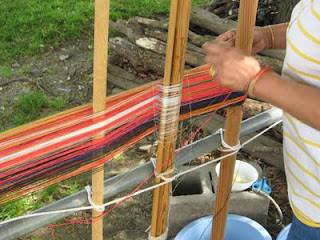For more photos and details on technique, see Photos/Videos > Lessons in Technique
THE BACKSTRAP OR BODY-TENSION loom has been used throughout South and Southeast Asia for thousands of years and is still used by Montagnard Dega in Vietnam and other hill tribes in neighboring countries.
 |
| Warp detail |
In traditional Montagnard weaving, the warp threads form a continuous loop or continuous warp around the breast beam (which sits close to the weaver’s lap) and the warp beam (which is either pressed taught by the weaver’s feet or is above the weaver's feet and attached to a heavy structure such as a table or two vertical posts). The breast beam is held in place by tying a rope from each side around the weaver’s waist. Tension is adjusted by the weaver pressing her feet more firmly up against the warp beam or shifting her weight backwards while pushing her feet up against a foot brace.
The weaver alternates the raising of the heddle rod and the shed stick which creates an opening for passing a spool or shuttle with the weft thread back and forth. To make each row of the textile tight and uniform the weaver beats down the weft with a sword stick.
As the weaving progresses the woven textile is rolled around the breast beam, which is two pieces of wood that clamp together.
Supplementary Thread Technique
The intricate patterns that characterize many Montagnard textiles are created by inserting threads into the main weave that form a contrast in color and design. From the front of the weaving these supplementary threads appear to be raised. If you look at the back side of the weaving you will see that these same threads appear to float on top of the warp or weft.
Montagnard Weaving: Pick Up Technique gives a brief description of loom technique.
Materials
Originally Montagnard Dega weavers grew their own cotton, spun their thread by hand, and used dyes from the indigo plant (Indigofera tinctoria) and other natural sources. Decorative elements such as beads once were made from plant materials that grew in their rice fields. Contemporary Montagnard Dega weavers in the U.S. cannot grow their own cotton or spin their fibers by hand as this would be far too labor intensive and would only add to the cost of purchasing a textile. Weavers in the U.S. now use manufactured, dye fast cotton as well as wool threads. For a skilled weaver this makes no difference in quality and allows her more color choices and opportunities to develop her design skills within the traditional format.


